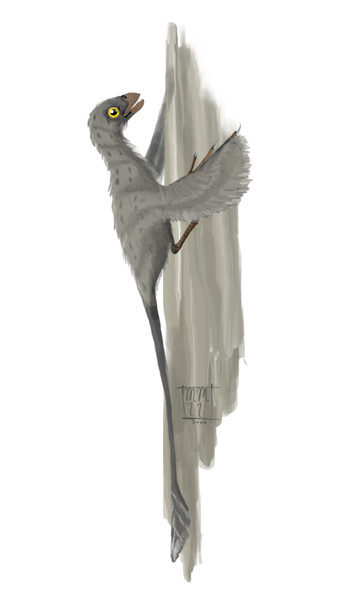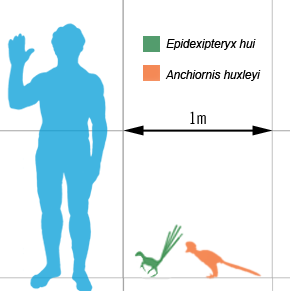[Recent Entries][Archive][Friends][User Info]
Below are the 2 most recent journal entries recorded in the "Сообщество, посвящённое ра" journal:| December 25th, 2012 | |
|---|---|
| 04:49 pm [industrialterro] [Link] |
Scansoriopteryx Scansoriopteryx ("climbing wing") is a genus of avialan dinosaur. Described from only a single juvenile fossil specimen found in Liaoning, China, Scansoriopteryx is a sparrow-sized animal that shows adaptations in the foot indicating an arboreal (tree-dwelling) lifestyle. It possessed an unusual, elongated third finger. The type specimen of Scansoriopteryx also contains the fossilized impression of feathers. Most researchers regard this genus as a synonym of Epidendrosaurus, with some preferring to treat Scansoriopteryx as the junior synonym, though it was the first name to be validly published. The type specimen of Scansoriopteryx heilmanni (specimen number CAGS02-IG-gausa-1/DM 607) represents the fossilized remains of a hatchling maniraptoran dinosaur, similar in some ways to Archaeopteryx. It is notable for its "primitive" non-perforated hip socket, and pubis (hip bone) which points forward, unlike some advanced maniraptorans. Most distinctive is its long third finger, which is almost twice as long as the second finger. This is unlike the configuration seen in all other theropods, where the second finger is longest. It also has an unusually large first toe, or hallux. A second specimen, the holotype of Epidendrosaurus ninchengensis (IVPP V12653), also shows features indicating it was a juvenile. The specimen is partially disarticulated, and most bones are preserved as impressions in the rock slab, rather than three-dimensional structures. Impressions indicate a relatively long tail. One distinctive feature of Scansoriopteryx is its elongated third finger, which is the longest on the hand (nearly twice as long as the second finger), and may be analogous to the insect-digging finger of the mammalian aye-aye (in most theropod dinosaurs, the second finger is the longest). Scansoriopteryx is also notable for its wide, rounded jaws. The lower jaw contained at least twelve teeth, larger in the front of the jaws than in the back. The lower jaw bones may have been fused together, a feature otherwise known only in the oviraptorosaurs. The tail was long, six or seven times the length of the femur, and ended in a fan of feathers. Because the only known specimens are juvenile, the size of a full-grown Scansoriopteryx is unknown–the type specimen is a tiny, sparrow-sized creature. ( Read More ) Репродукции (1, 2, 3, 4, 5, 6, 7, 8):
В когтях вот у этого вот паучка. ( Read More )
Tags: Вымершие рептилии, Юра, авеметатарзалии, авиалы, архозавроморфы, архозавры, диапсиды, динозавроморфы, динозавры, манирапторы, скансориоптеригиды, тероподы, целурозавры, ящеротазовые |
| October 15th, 2012 | |
| 08:06 pm [industrialterro] [Link] |
Epidexipteryx Epidexipteryx ("display feather") is a genus of small avialan dinosaur, known from one fossil specimen in the collection of the Institute of Vertebrate Paleontology and Paleoanthropology in Beijing. Epidexipteryx represents the earliest known example of ornamental feathers in the fossil record. The type specimen is catalog number IVPP V 15471. It has been reported to be a maniraptoran dinosaur from the Middle Jurassic or Upper Jurassic age Daohugou Beds of Inner Mongolia, China (about 152 to 168 mya). The specific name, Epidexipteryx hui ("Hu's display feather"), and its Chinese name Hushi Yaolong ("Hu Yaoming's dragon") were coined in memory of paleomammologist Hu Yaoming. It is known from a well preserved partial skeleton that includes four long feathers on the tail, composed of a central rachis and vanes. However, unlike in modern-style rectrices (tail feathers), the vanes were not branched into individual filaments but made up of a single ribbon-like sheet. Epidexipteryx also preserved a covering of simpler body feathers, composed of parallel barbs as in more primitive feathered dinosaurs. However, the body feathers of Epidexipteryx are unique in that some appear to arise from a "membranous structure" at the base of each feather. It has been suggested that this may represent a stage in the evolution of the feather. In all, the skeleton of Epidexipteryx hui measures 25 centimeters (10 inches) in length (44.5 cm or 17.5 in including the incomplete tail feathers), and the authors estimated a weight of 164 grams, smaller than most other basal avialans. The skull of Epidexipteryx is also unique in a number of features, and bears an overall similarity to the skull of Sapeornis, oviraptorosaurs and, to a lesser extent, therizinosauroids. It had teeth only in the front of the jaws, with unusually long front teeth angled forward, a feature only seen in Masiakasaurus among other theropods. The rest of the skeleton bore an overall similarity to the closely related Scansoriopteryx, including a hip configuration unusual among other dinosaurs: the pubis was shorter than the ischium, and the ischium itself was expanded towards the tip. However, the tail of Epidexipteryx differed significantly from Scansoriopteryx. In Scansoriopteryx, the tail was long, about 300% of total trunk length, while the short tail of Epidexipteryx was only 70% of its trunk length. The tail of Epidexipteryx also bore unusual vertebrae towards the tip which resembled the feather-anchoring pygostyle of modern birds and some oviraptorosaurs. Despite its close relationship to avialan birds, Epidexipteryx appears to have lacked remiges (wing feathers), and it likely could not fly. Zhang et al. suggest that unless Epidexipteryx evolved from flying ancestors and subsequently lost its wings, this may indicate that advanced display feathers on the tail may have predated flying or gliding flight. У птиц в очередной раз сменился «самый старший предок». Эпидексиптерикс Ху, или Epidexipteryx hui по латыни, может войти в учебники биологии наравне с археоптериксом, которого новый юрский вид старше. По мнению китайских учёных, нашедших окаменелость во Внутренней Монголии, первенство эпидексиптерикса доказывает его хвост. Происхождение птиц – если и не уникальный, то, наверное, самый спорный момент в эволюции. Хотя гипотетическое описание переходной формы от динозавров к птицам создано более века назад, ископаемые виды, занимающие это почётное место, регулярно меняются – конечно, не по своей воле, а благодаря ученым, требующим торжества истины, а может быть, просто желающим увековечить свое имя в названии вида. Очередная смена «царя горы», может быть, и осталась бы незамеченной, но только не в русскоговорящей научной среде. И все благодаря знаменитому китайскому специалисту по животным мезозойской эры Яомину Ху, скончавшемуся в апреле этого года. Коллеги покойного палеонтолога по Институту палеонтологии позвоночных и палеоантропологии Китайской академии наук увековечили в видовом имени нового ископаемого фамилию Ху. По мнению китайских палеонтологов, Epidexipteryx hui, окаменелости которого датируются промежутком с 152-го до 168-го миллионов лет назад, должен расположиться у основания всего клада Avialae. В эту группу входят не только птицы, но и их ближайшие родственники среди динозавров. И хотя для окончательных выводов о роли эпидексиптерикса (от греческого «показывающий перья») в эволюции необходимо провести дополнительные сравнения и, что немаловажно, заручиться поддержкой коллег, у «пернатого динозаврика» есть все шансы стать предком самого археоптерикса. По мнению Фучэна Чжана и его коллег, эпидексиптерикс Ху должен располагаться у основания клада Avialae, включающего всех птиц и их динозавровых родственников. Эпидексиптериксов и эпидендрозавров учёные выделили в клад Scansoriopterigidae, однако несколько признаков заставляют их всё же отдать «первенство» именно новооткрытому виду. Находка была сделана во Внутренней Монголии на территории Китая и относится к средней или верхней эпохе юрского периода, что совпадает с современными представлениями о возникновении и эволюции пернатых. Облик эпидексиптерикса тоже неплохо вписывается в эти самые современные представления. Небольшой размер, масса около 160 грамм, выступающая нижняя челюсть с уплощенными, хотя и увеличенными зубами, но главное, как водится, – хвост. Конечно, не такой, как у птиц, но уже и не такой, как у рептилий. Сросшиеся хвостовые позвонки, на конце увенчанные четырьмя торчащими перьеподобными структурами. Именно такой хвост позволил Фучэну Чжану и его коллегам говорить о преимуществах эпидексиптерикса перед эпидендрозаврами, ранее располагавшимися в основании ветви Avialae. Во-первых, у эпидексиптерикса хвост короче – всего лишь 70% от длины тела, а не все 300%, как у эпидендрозавров. Во-вторых, у E.hui меньше позвонков – 16 против 40 у большинства эпидендрозавров, и они более плоские. Крыльев как таковых у эпидексиптерикса не было, хотя скелет передних конечностей уже близок к таковому у птиц. Отсутствие контурных перьев делало полет физически невозможным. Как отметили учёные, эта группа активно экспериментировала с оперением и строением скелета, а именно в этом заключаются принципиальные отличия птиц, сделавшие возможным полёт. Остальные особенности, среди которых интенсивный обмен веществ и идеальная нервная система, совершенствовались уже «в полете» за счет внутренней конкуренции. ( Далее ) Репродукции (1, 2, 3, 4, 5, 6, 7, 8):
( Далее ) Размеры тела в сравнении с человеком и анхиорнисом (закрашен зелёным цветом):
Tags: Вымершие рептилии, Юра, авеметатарзалии, авиалы, архозавроморфы, архозавры, диапсиды, динозавроморфы, динозавры, манирапторы, скансориоптеригиды, тероподы, целурозавры, ящеротазовые |















